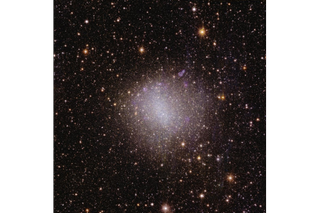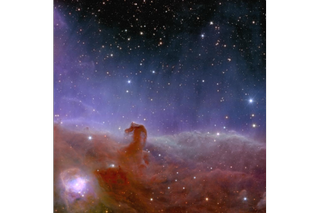The European Space Agency (ESA) will release five new images from the Euclid Space Telescope on Thursday (May 23rd). And, well, if the previous set of images is anything to go by – space fans should be in for a real treat.
“Five new portraits of our universe were taken during Euclid’s early observing phase, each revealing incredible new science,” ESA officials said in a statement. “Euclid’s ability to unlock the secrets of the cosmos is something you don’t want to miss.”
The new images will be revealed at 05:00 EDT (12:00 CEST) and will be accompanied by an incredible 10 scientific papers. You can follow the data release live on ESA’s YouTube channel.
Related: Euclid’s ‘dark space’ telescope defrosts from a million miles away
As an appetizer for this occasion, perhaps we can recall the incredible cosmic images that this mission has delivered so far.
Euclid’s story so far
Launched on July 1, 2023, from Cape Canaveral, Florida atop a SpaceX Falcon 9 rocket, Euclid is a wide-angle space telescope carrying a 600-megapixel camera that observes the cosmos in visible light, a near-infrared spectrometer, and a photometer used to determine the redshift of galaxies. Knowing the redshift allows scientists to determine how fast distant galaxies are moving away from our planet.
Euclid’s primary mission is to investigate the two most mysterious elements of the universe: dark energy and dark matter. Together, these phenomena make up what is often called the “dark universe.”
Dark energy is a placeholder name for any force that causes the expansion of the universe to accelerate. Dark matter, on the other hand, is a form of matter that is actually invisible because it does not interact with light. This means that scientists know that stars, planets, moons and our bodies are not “ordinary” matter made up of electrons, protons and neutrons. Dark matter can only make its presence known through its interactions with gravity, which in turn can affect ordinary matter and light. However, to be clear, neither dark matter nor dark energy are necessarily composed of one thing. Both may be made of many things – or, perhaps they are indeed each made of one homogeneous thing.
The point is, we just don’t know.
Despite this, dark energy is thought to make up about 68% of the universe’s energy and matter budget, while dark matter makes up about 27%. This means that the dark universe makes up 95% of the stuff in the universe, and the stuff we actually understand makes up only about 5%.
So, dubbed the “detective of the dark universe” because of its specific suite of instruments, Euclid clearly has its work cut out for it. But surely the first official images of the space telescope released on November 7, 2023, after its first four months in space, showed that it was up to the task.

Just above is one of the first images the public saw from the Euclid telescope. It’s a snapshot that shows about 1,000 galaxies, all of which belong to the Perseus cluster. Located about 240 million light years from Earth, this cluster is one of the largest structures in the known universe.
Mapping galaxies in such large quantities is crucial to understanding how dark matter is distributed and how this distribution has affected the evolution of the universe.
In addition to the abundance of galaxies in the Perseus cluster, the image also showed an additional 100,000 much more distant galaxies, each containing up to hundreds of billions of stars. Observations of distant galaxies in large numbers like this are key to Euclid’s discovery of how dark energy pushes these galaxies faster and faster, accelerating the expansion of the space between them.

Just because Euclid cast his eye over vast swaths of galaxies doesn’t mean he can’t impress with pictures of individual galaxies.
Another of the first Euclid images we could see was somewhat ironic for an instrument tasked with detecting the dark elements of the universe. This is because it identified the galaxy IC 342, also known as the “Hidden Galaxy”.
This galaxy is located about 11 million light-years from Earth and is difficult to image because it lies behind the bright, dusty disk of the Milky Way. However, this did not stop Euclid from taking an amazing picture of this once hidden spiral galaxy. To do this, the space telescope used its near-infrared instrument, which is an advantage because the gas and dust of the Milky Way’s disk are less efficient at absorbing infrared light compared to other wavelengths of electromagnetic radiation.

To unravel the mysteries of the dark universe and create a detailed 3D map of the cosmos, Euclid will need to see galaxies as far away as 10 billion light years by seeing the 13.8 billion year old universe as it was less than 4 years ago. billions of years after the Big Bang.
These galaxies are unlikely to have the neat, spiral arrangements of the Milky Way or even the Hidden Galaxy. Most galaxies in the early universe are “spots,” poorly shaped, irregular galaxies that served as building blocks for larger galaxies.
To prepare for observing these distant and early galaxies, Euclid’s first images included a view of a more local irregular galaxy, NGC 6822, located just 1.6 million light-years from Earth.

Although they offer us spectacularly sparkling images, Euclid will not only focus on galaxies during its mission.
As the above image of NGC 6397 shows, the space telescope will also observe globular clusters. And, fortunately, globular clusters are just as beautiful. They are conglomerates of hundreds of thousands of stars bound together by gravity and are some of the oldest structures in the known universe.
NGC 6397 is the second closest globular cluster to Earth, only about 7,800 light-years away. Globular clusters like NGC 6397 orbit the Milky Way’s disk and may hold clues about the evolution of our galaxy, or at least other galaxies that host such structures.
Euclid will excel at studying globular clusters because, unlike other telescopes, it has a wide enough field of view to capture entire globular clusters in a single image, just as it did for NGC 6397.

Much of the Euclid mission will focus on the unknown, but the latest image from the first batch of Euclid releases actually showed us a familiar celestial object in a whole new light. A dark space detective has managed to create a stunningly detailed panoramic view of the Horsehead Nebula, also known as Barnard 33.
Located about 1,380 light-years from Earth and located near the east of Orion’s Belt, the Horsehead Nebula is one of the closest star-forming clouds of gas and dust to the Solar System. It is also a sight to behold.
Although many telescopes have imaged the Horsehead Nebula in the past, none have captured this region of Orion’s molecular cloud with such a wide and sharp view. What’s even more amazing about this picture is that it only took Euclid an hour of observation to create it. It’s no wonder that professional and amateur astronomers and space fans are excited about the upcoming data release on May 23rd.
To that end, as breathtaking as the images above are, there’s a good chance the best is yet to come from Euclid as it begins to fulfill its mission objectives while shedding unusual light on the dark universe.
We’ll have to wait until early Thursday to see what the next batch of Euclid images brings, and to see how this dark space detective begins to live up to his high mission expectations after nearly a year in space. But then again, if his past is any indication of his future, it’s hard to imagine anything but information-rich beauty from these images.